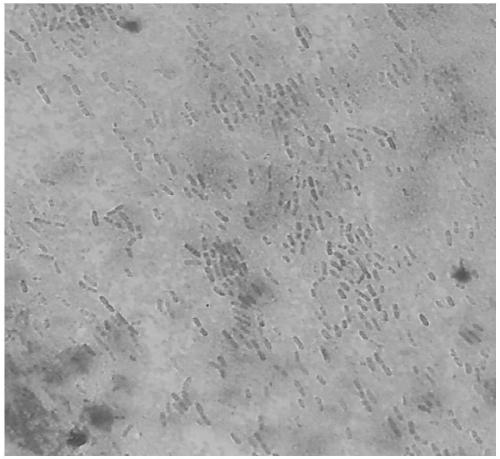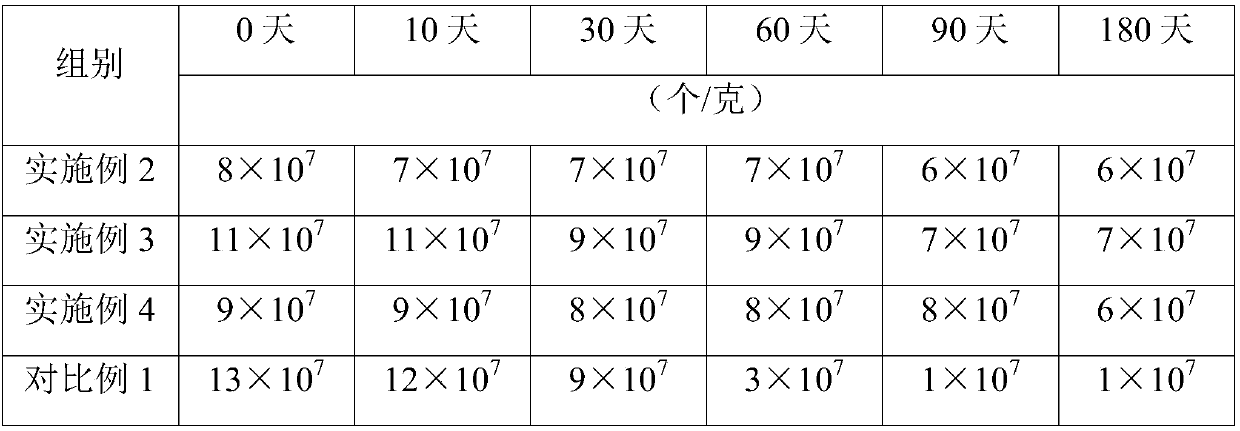Thermophilic Bacillus smithii Ths1 and applications thereof
A technology of thermophilic bacteria, cgmccno.16868, applied in the direction of bacteria, organic fertilizers, microorganisms, etc., can solve the problems of poor metabolic capacity, poor high temperature adaptability, incomplete transformation of organic matter, etc., and achieve long high temperature maintenance time and strong high temperature adaptability , to speed up the effect of the composting process
- Summary
- Abstract
- Description
- Claims
- Application Information
AI Technical Summary
Problems solved by technology
Method used
Image
Examples
Embodiment 1
[0028] A thermophilic bacterium Bacillus smithii Ths1, the strain deposit number is CGMCC No. 16868. The selection process is as follows: collect a compost sample (cow dung compost) from the vertical fermentor of Anhui Hefei Xiaogang Biotechnology Co., Ltd. in normal operation. The temperature of the compost is about 70℃. Weigh 10g of high-temperature compost sample to fill 90mL In a 250mL Erlenmeyer flask (containing glass beads) of sterile normal saline, place it on a shaker and shake for 20 minutes. Suction 0.1ml compost sample, dilute it by 10, 100 and 1000 times and spread on LB plate medium at 65℃. Cultivate in an incubator. After 24 hours, select strains with different colony sizes from the plates, and use LB plates for 5 streak separation and purification to obtain monoclonal thermophilic bacteria strains. After the strains are plated for 5 times, each strain is picked 5 A single colony was cultured at 65°C to determine the genetic stability of the strain's high-tempera...
Embodiment 2
[0033] The thermophilic bacterium Bacillus smithii Ths1 selected in Example 1 can be used to prepare an inoculant. The inoculant includes a bacterial adsorption substrate and a thermophilic bacterium Bacillus smithii Ths1 powder. The preparation method of the inoculant specifically includes the following process steps:
[0034] a. Activated strain: streakly inoculate the thermophilic Bacillus smithii Ths1 strain stored at -80°C on LB plates, and culture at 60°C for 24h.
[0035] b. Liquid culture: Use an inoculating loop to scrape the lawn of the thermophilic bacterium Bacillus smithii Ths1 and inoculate it in an Erlenmeyer flask containing LB liquid medium, and culture it on a shaker at 60°C and 200r / min for 24h.
[0036] c. Seed liquid fermentation: inoculate the thermophilic bacteria Bacillus smithii Ths1 culture solution obtained in step b in a 10L seed tank, ferment for 24h at 60°C and 200r / min; the fermentation medium is PB medium, and the thermophilic bacteria Bacillus smithiiT...
Embodiment 3
[0040] The thermophilic bacterium Bacillus smithii Ths1 selected in Example 1 can be used to prepare an inoculant. The inoculant includes a bacterial adsorption matrix and a dry bacterial powder of the thermophilic bacterium Bacillus smithii Ths1. The preparation method of the inoculant specifically includes the following process steps :
[0041] a. Activated strain: streakly inoculate the thermophilic Bacillus smithii Ths1 strain stored at -80°C on an LB plate and culture at 65°C for 12 hours.
[0042] b. Liquid culture: Use an inoculating loop to scrape the lawn of the thermophilic bacterium Bacillus smithii Ths1 and inoculate it in an Erlenmeyer flask containing LB liquid medium, culture at 65°C and 200r / min on a shaker for 12 hours.
[0043] c. Fermentation of seed liquid: inoculate the thermophilic bacteria Bacillus smithii Ths1 culture liquid obtained in step b into a 10L seed tank, and ferment at 65°C and 200r / min for 24 hours; the fermentation medium is PB medium, and the the...
PUM
| Property | Measurement | Unit |
|---|---|---|
| diameter | aaaaa | aaaaa |
Abstract
Description
Claims
Application Information
 Login to View More
Login to View More - R&D
- Intellectual Property
- Life Sciences
- Materials
- Tech Scout
- Unparalleled Data Quality
- Higher Quality Content
- 60% Fewer Hallucinations
Browse by: Latest US Patents, China's latest patents, Technical Efficacy Thesaurus, Application Domain, Technology Topic, Popular Technical Reports.
© 2025 PatSnap. All rights reserved.Legal|Privacy policy|Modern Slavery Act Transparency Statement|Sitemap|About US| Contact US: help@patsnap.com



